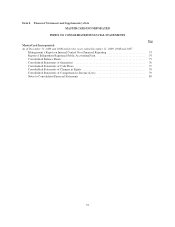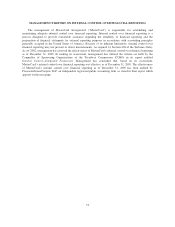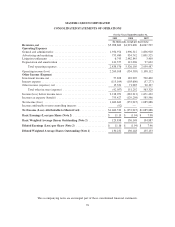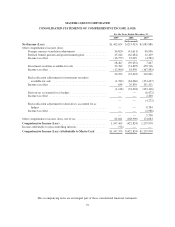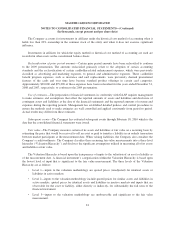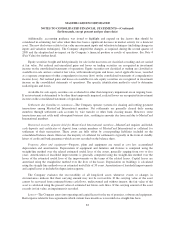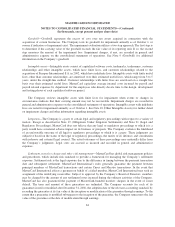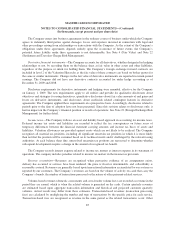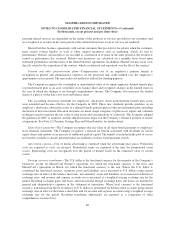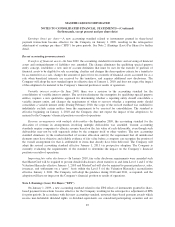MasterCard 2009 Annual Report Download - page 92
Download and view the complete annual report
Please find page 92 of the 2009 MasterCard annual report below. You can navigate through the pages in the report by either clicking on the pages listed below, or by using the keyword search tool below to find specific information within the annual report.MASTERCARD INCORPORATED
NOTES TO CONSOLIDATED FINANCIAL STATEMENTS—(Continued)
(In thousands, except percent and per share data)
Certain assets and liabilities are measured at fair value on a nonrecurring basis. The Company’s assets and
liabilities measured at fair value on a nonrecurring basis include property, plant and equipment, goodwill and
other intangible assets. These assets are not measured at fair value on an ongoing basis; however, they are subject
to fair value adjustments in certain circumstances, such as when there is evidence of impairment.
The valuation methods for goodwill and other intangible assets involve assumptions concerning discount
rates, growth projections and other assumptions of future business conditions. As all of the assumptions
employed to measure these assets and liabilities on a nonrecurring basis are based on management’s judgment
using internal and external data, these fair value determinations are classified in Level 3 of the Valuation
Hierarchy. See Note 4 (Fair Value) for information about methods and assumptions. The Company has not
elected to apply the fair value option to its eligible financial assets and liabilities.
Cash and cash equivalents—Cash and cash equivalents include certain liquid investments with a maturity of
three months or less from the date of purchase. Cash equivalents are recorded at cost, which approximates fair
value.
Investment securities—The Company classifies debt securities as held-to-maturity or available-for-sale and
classifies equity securities as available-for-sale or trading. Available-for-sale securities that are available to meet
the Company’s current operational needs are classified as current assets. Available-for-sale securities that are not
available to meet the Company’s current operational needs are classified as non-current assets.
Debt securities are classified as held-to-maturity when the Company has the intent and ability to hold the
debt securities to maturity and are stated at amortized cost. Debt securities not classified as held-to-maturity are
classified as available-for-sale and are carried at fair value, with unrealized gains and losses, net of applicable
taxes, recorded as a separate component of other comprehensive income (loss) on the consolidated statements of
comprehensive income (loss). Net realized gains and losses on debt securities are recognized in investment
income on the consolidated statements of operations.
The fair values of the Company’s short-term bond funds are based on quoted prices and are therefore
included in Level 1 of the Valuation Hierarchy. The fair values of the Company’s available-for-sale municipal
bonds are based on quoted prices for similar assets in active markets and are therefore included in Level 2 of the
Valuation Hierarchy. The fair value determination for the Company’s Auction Rate Securities (“ARS”) is based
primarily on an income approach and is therefore included in Level 3 of the Valuation Hierarchy. See Note 4
(Fair Value) and Note 5 (Investment Securities) for additional disclosures related to the fair value standard.
The Company has incorporated the considerations of guidance pertaining to determining the fair value of
financial assets in inactive markets in its assessment of the fair value of its ARS as of December 31, 2009 and
2008. The guidance provides consideration of how management’s internal cash flow and discount rate
assumptions should be considered when measuring fair value when relevant observable data does not exist, how
observable market information in a market that is not active should be considered when measuring fair value and
how the use of market quotes should be considered when assessing the relevance of observable and unobservable
data available to measure fair value.
During 2009, accounting standards changed for the method for determining whether an other-than-
temporary impairment exists for debt securities and the amount of an impairment charge to be recorded in
earnings. Enhanced disclosures must include the Company’s methodology and key inputs used for determining
the amount of credit losses recorded in earnings. The Company adopted these changes during the second quarter
of 2009 and the adoption had no impact on the Company’s financial position or results of operations. See Note 5
(Investment Securities) for further detail.
82


